
کلینیک فوق تخصصی دانش آموخته لوله کشی صنعتی ۸۳-۸۴ ( نفت و گاز ) - مایترکاری
سایتی نو و نخست برای ارائه راهنمای ساخت انواع شابلون پایپینگ به Fabricator ها و بالا بردن دانش ریاضی ایشان
کلینیک فوق تخصصی دانش آموخته لوله کشی صنعتی ۸۳-۸۴ ( نفت و گاز ) - مایترکاری
سایتی نو و نخست برای ارائه راهنمای ساخت انواع شابلون پایپینگ به Fabricator ها و بالا بردن دانش ریاضی ایشاندرباره من
نظرسنجی
روزانهها
همه- حد پذیرش تست مایعات نافذ Asme Viii Appendix 8
- افسانه شیان فان
- انهدام شبکه جاسوسی در یمن شکست غرب و اروپا در یمن
- طرح نعل اسبی سایت موشکی در سوریه آماده برای شلیک به اسرائیل
- قضیه تالس
- داروی اوسلتامیویر (تامی فلو) برای درمان و پیشگیری از آنفولانزا داروی آنفولانزا
- عزیز جون پرستو ... کنسرت کاروانسرا
- Y Ducting Connector تبدیل Y شکل گالوانیزه Air Ducting
- سایت
- تفسیر قانون پذیرش پزشکی بدون کنکور المپیک 2024
- طرح جدید پذیرش بدون کنکور پزشکی المپیکیها مدال بیار بدون کنکور رشته پزشکی بخون
- مسابقات جهانی آرایش
- جولان افاغنه در ایران از خرید تا اجاره ملک
- یا حسین میر حسین
- کیست تخمدان مراجعه به پزشک زنان قبل از وقوع یا مرحله کم خطر بودن
پیوندها
- برخورداستوانه و مخروط
- برنچ
- رفتارشما
- Jalali Calendar میلادی-شمسی
- Whats app دانلود
- Fabrication راهنمای ساخت
- Slope In Piping روش محاسبه شیب در پایپینگ
- شکستگی و پروتز گردن ران ( فمور )
- ساپورت دامی - زانوئی چند تکه - شلوارک
- مهسا امینی دستگیری بعلت بدحجابی ، از سکته او در پلیس امنیت در جریان بحث و وفات در بیمارستان کسری تهران دهه سوم شهریور ۱۴۰۱
- رحم اجاره ای اخاذی بین ۱۰۰ تا ۲۰۰ میلیون و ماهی ۳ میلیون در سال ۱۴۰۱ و نبود قانون
- مهسا امینی - اعتراضات اواخرشهریور ۱۴۰۱
- اعتراضات شهریور۱۴۰۱
- احکام 18+
- قانون Control Banding بازرسی محوطه کاری ، سرزمینی یا مرزهای دریایی
- The day of revenge is near
- Maximum Allowable Stress Section ii part D تنش مجاز متریال A106 Grade B در دمای ۴۳۵ درجه سانتیگراد
- Thickness Calculation of blind flange مثال هایی برای محاسبه ضخامت ورق برای ساخت فلنج کور بر اساس UG-34
- Bolt root and tensile stress area
- Pressure-Temperature rating B16.5
- Yield Strength for material A105 section ii part D استحکام تسلیم فلنج A105 جدول Y-1 سکشن ii در دماهای مختلف
- Required Wall thickness حداقل ضخامت مورد نیاز براساس بند ug-34 و فرمول یک اپندیکس 2 ( سرهای مسطح دایره ای )
- ( Required Wall Thickness ( Mininmum مثال از حداقل ضخامت Blind flange سایز ۳۴ اینچ
- Flange rating Maximum Design Pressure - حداکثر فشار طراحی بر اساس Asme B16.5
- دختران ایرانی زیر پای سگ های ارتش آمریکا توضیحاتی درباره وضعیت برخی دختران در زمان شاه
- Maximum Stress value SA-312 TP316L حداکثر تنش مجاز متریال در دماهای مختلف
- Asme PCC-1 appendix H-O bolt stress - bolt root area
- Root area + Tensile stress area Bolt
- Bolt root + tensile area ASME B1-1 for threads
- داستان سید مهدی قوام و زن ...
- شارلی ابدو فرانسه
- تجاوز وحشیانه چند افغان به یک زن جوان در فرحزاد
- ورزش با حرکات موزون + موسیقی
- دامی ساپورت انواع مختلف نصب
- اپلیکیشن دامی ، مایتر زانویی و شلوارک
- YJC.IR
- عیوب جوش
ابر برچسب
شابلون برنچ Dummy support Unequal Branch Miter دامی ساپورت Branch Miter bend piping PWHT Dummy پایپینگ Pipe Branch ELBOW DEGREE مخروط ناقص impact test مهسا امینی ردیوسر Pipe To Cone شابلون دامی ساپورت Y Pieceجدیدترین یادداشتها
همه- جوشکاری تعمیری E 200 Repair welding procedures 201.Repair welding shall be qualified by a separate weld repair qualification test ....
- Sizing 6dB or 20dB Drop زمانیکه اندازه ناپیوستگی بزرگتر از قطر ترانسدیوسر باشد، طول ناپیوستگی با قانون ۶ دسی بل قابل اندازه گیری است. اسکن می...
- بازرسی جوش به روش UT و حد پذیرش یک استاد دانشگاه درباره اقدام اخیر متروی تهران نوشت: برگزاری مسابقه نامه خودمونی به خدا از سوی مترو کار خوبی است اما...
- Piping isometric elbow degree calculation یک استاد دانشگاه درباره اقدام اخیر متروی تهران نوشت: برگزاری مسابقه نامه خودمونی به خدا از سوی مترو کار خوبی است اما...
- سوالات تست مایعات نافذ ASNT Developer types Dry powder method of application : Dust/fog, dip Application sequence : After drying Dwell time : 1/2...
- multiple PQRs used to support a single WPS, مدیران اماکن عمومی و صاحبان و متصرفان اماکن خصوصی موظفاند توقف اتباع خارجی را ظرف مدت 24 ساعت پس از ورود آنان، به مرجع...
- Thickness Of Base Metal Qualified پدر دانشآموزان جانباخته خطاب به وزیر آموزش و پرورش: نه تسلیت میخواهم watch ‹ www.youtube.com ۲۱ بهمن ۱۴۰۳ · پدر...
- TEST COUPON IN PIPE AND MIN LENGTH مدیران اماکن عمومی و صاحبان و متصرفان اماکن خصوصی موظفاند توقف اتباع خارجی را ظرف مدت 24 ساعت پس از ورود آنان، به مرجع...
- هدف از صلاحیت جوشکار هدف از احراز صلاحیت فردی که از فرآیند اتصال استفاده می کند، نشان دادن توانایی آن فرد برای تولید یک اتصال سالم و بی عیب...
- VALVE DBB ( double block and bleed ) شیر انسداد و تخلیه ... با دو سطح نشیمن که در حالت بسته، در برابر فشار از دو سر شیر با...
- Visual Testing Quiz تقریظ واژهای عربی مأخوذ از «قَرَظَ»، در لغت به معنای مدح و ستایش است. قَرِظَ قرظاً؛ مهترو ارجمند گردید بعدِ مذلت و...
- PT QUIZ -کندن کانال چندروز طول کشید؟ در مجموع ۵۵ روز کانال کندیم و در ۹ روز آخر فقط من و حسن رعیت بودیم که خوشبختانه توانستیم...
- Wire IQI حکم اعدام ظریف در دادگاه صحرایی چه معنایی دارد؟ - فرارو سیاست ‹ سیاست ‹ fararu.com ۱۳ بهمن ۱۴۰۳ ... ظریف برکنار و...
- PIPING-NDT پسر قاضی مقیسه در صفحه شخصی خود در فضای مجازی نوشت: حاجی دو بار برای عمل جراحی نیروی خدماتی (قاتل منافق) از همه قضات...
- انجام تست جوش با روش مایعات نافذ بهمن ماه ۱۴۰۳ پسر قاضی مقیسه در صفحه شخصی خود در فضای مجازی نوشت: حاجی دو بار برای عمل جراحی نیروی خدماتی (قاتل منافق)...
- Cone ترک ها ضرب المثلی دارند که : balık baştan kokar یعنی ماهی از سر گندیده میشود. منظور این است که آب از سرچشمه گل آلود...
- فشار تست در High Pressure piping فصل IX سلام بر او؛ روزى که زاده شد و روزى که مىمیرد و روزى که دیگر بار زنده برانگیخته مىشود. ( حضرت عیسی ) for the signs of...
- Severe cyclic condition Severe cyclic is not a fluid service 305.2.3 Pipe for Severe Cyclic Conditions (a) Except as limited in (b) through (d)...
- درصد رادیوگرافی طبق Asm3 B31.3 حکم اعدام ظریف در دادگاه صحرایی چه معنایی دارد؟ - فرارو سیاست ‹ سیاست ‹ fararu.com ۱۳ بهمن ۱۴۰۳ ... ظریف برکنار و...
- TESTING کپسول تامیفلو (تامی فلو) 45 میلی گرم | TAMIFLU Capsule 45 mg TAMIFLU-Capsule-4... ‹ www.darooyab.ir موارد مصرف کپسول...
- Y Ducting Connector ventilation اسلتامیویر دارو اُسِلتامیویر با نام تجاری تامیفلو یک داروی آنتیویروس است که فعالیت ویروس آنفلوآنزا را در بدن مسدود...
- Lateral Pipe Branch 12 × 4 thk 5.49 سرانجام بشار اسد در ۱۸ آذر ۱۴۰۳ سرنگون گردید زندان صیدنایا - ویکیپدیا، دانشنامهٔ آزاد زندان_صیدنایا ‹ wiki ‹...
- Elbow Side Joint ویدیویی از یک مدیر در کارخانهای در فضای مجازی منتشر شده که سراغ کارگرانش میرود و به آنها بابت نزدن ریششان هشدار...
- زاویه بین سوراخ های فلنج 360 ÷ Number Of Holes چهلم ( ۱۰ آبانماه ۱۴۰۳ ) مجاهدان عرصه اقتصاد کشور روحشان شاد و یادشان گرامی فوت ( ۵۳ نفر ) : بعلت...
- CON PIPE REDUCER امیر نصیرزاده در پاسخ به سوالی درباره آسیب دیدن یک مرکز در شاهرود و احتمال حمله از مرزهای شمالی عنوان کرد: خیر چنین...
- ماکزیمم فشار داخلی مجاز برای لوله ها در مخازن تحت فشار MAWP امیر نصیرزاده در پاسخ به سوالی درباره آسیب دیدن یک مرکز در شاهرود و احتمال حمله از مرزهای شمالی عنوان کرد: خیر چنین...
- CLOD BEND طبق استاندارد ملی گاز ایران ماکزیمم زاویه خم بر اساس ۱۲ متر لوله داده شده مثلاً برای سایز ۴ اینچ حداکثر 118 درجه ... در...
- رسم فنی انشعاب y piece
- Duct Pattern ..... مایترکاری ۲۹ مهر ۱۴۰۲ ۱۹ روز پس از عملیات موشکی ایران علیه اسرائیل، خبرگزاری فارس از قول یک منبع آگاه نوشت که در این عملیات (...
- نیاز به تست ضربه و معافیت ها در Asme سکشن 8 بخش یک بازداشت بعلت اقدام علیه امنیت ملی ASME VIII DIV 1 2017 UG-20(f) →→→UCS-66(a) →→→ UCS-66(b) →→→UCS-68(c) در وهله اول به...
بایگانی
- اردیبهشت 1404 4
- فروردین 1404 1
- بهمن 1403 8
- دی 1403 5
- آذر 1403 3
- آبان 1403 8
- مهر 1403 15
- شهریور 1403 28
- مرداد 1403 3
- تیر 1403 2
- خرداد 1403 12
- اردیبهشت 1403 20
- فروردین 1403 2
- اسفند 1402 3
- بهمن 1402 11
- دی 1402 24
- آذر 1402 55
- آبان 1402 17
- مهر 1402 1
- شهریور 1402 3
- مرداد 1402 1
- خرداد 1402 3
- اردیبهشت 1402 3
- فروردین 1402 4
- اسفند 1401 10
- بهمن 1401 15
- آذر 1401 8
- آبان 1401 25
- مهر 1401 7
- شهریور 1401 13
- مرداد 1401 6
- تیر 1401 2
- خرداد 1401 13
- اردیبهشت 1401 1
- دی 1400 2
- آذر 1400 15
- آبان 1400 44
- شهریور 1400 6
- مرداد 1400 27
- تیر 1400 38
- خرداد 1400 16
- اردیبهشت 1400 4
- فروردین 1400 10
- اسفند 1399 8
- بهمن 1399 6
- دی 1399 3
- آذر 1399 2
- شهریور 1399 9
- فروردین 1399 10
- بهمن 1398 12
- آذر 1398 8
- آبان 1398 5
جستجو
نیاز به تست ضربه و معافیت ها در Asme سکشن 8 بخش یک
بازداشت بعلت اقدام علیه امنیت ملی
ASME VIII DIV 1 2017
UG-20(f) →→→UCS-66(a) →→→ UCS-66(b) →→→UCS-68(c)
در وهله اول به (UG-20(f مراجعه می شود اگر موارد زیر حکمفرما بود تست ضربه ضروری نیست.
مثل : محدود به P نامبر یک گرید 1 و 2 ، ضخامت حاکم در منحنی A از ۱۳ میلیمتر و برای سایر منحنی ها از ۲۵ میلیمتر بیشتر نشود ، مخزن تحت فشار تحت فشار هایدروتست یا جایگزین تست نیوماتیک گردد ، دمای طراحی بین 29- تا 345 درجه سانتیگراد باشد و ...
در مرحله بعد به شکل UCS-66 ( حاکم بر فولادهایی که در قسمت UCS فهرست شده ) مراجعه می شود ، تست ضربه برای ترکیبی از دمای حداقل فلز و ضخامت حاکم بر قطعه بررسی میشود. اگر برخورد MDMT و ضخامت حاکم ، رو یا بالای منحنی قرار گرفته باشد تست ضربه اجباری نیست . داده های شکل UCS-66 در جدول UCS-66 فهرست و جدول بندی شده.
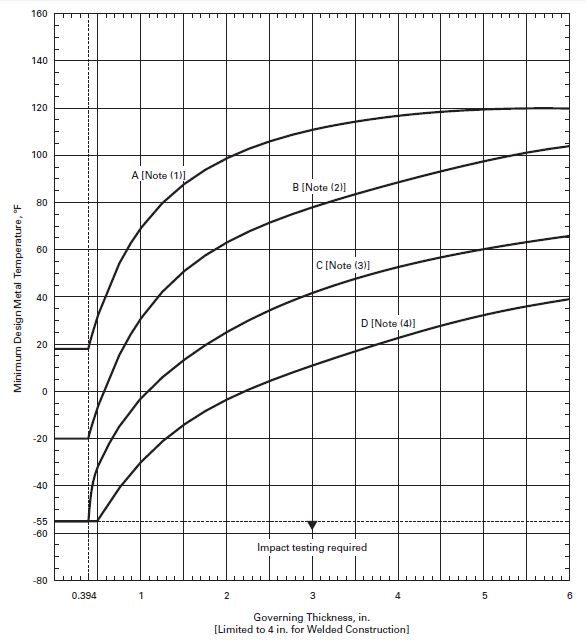
مثلاً در شکل برخورد تلاقی خطوط ضخامت 2 اینچ و دمای 4- روی منحنی D قرار گرفته در نتیجه تافنس تست ضروری نیست.
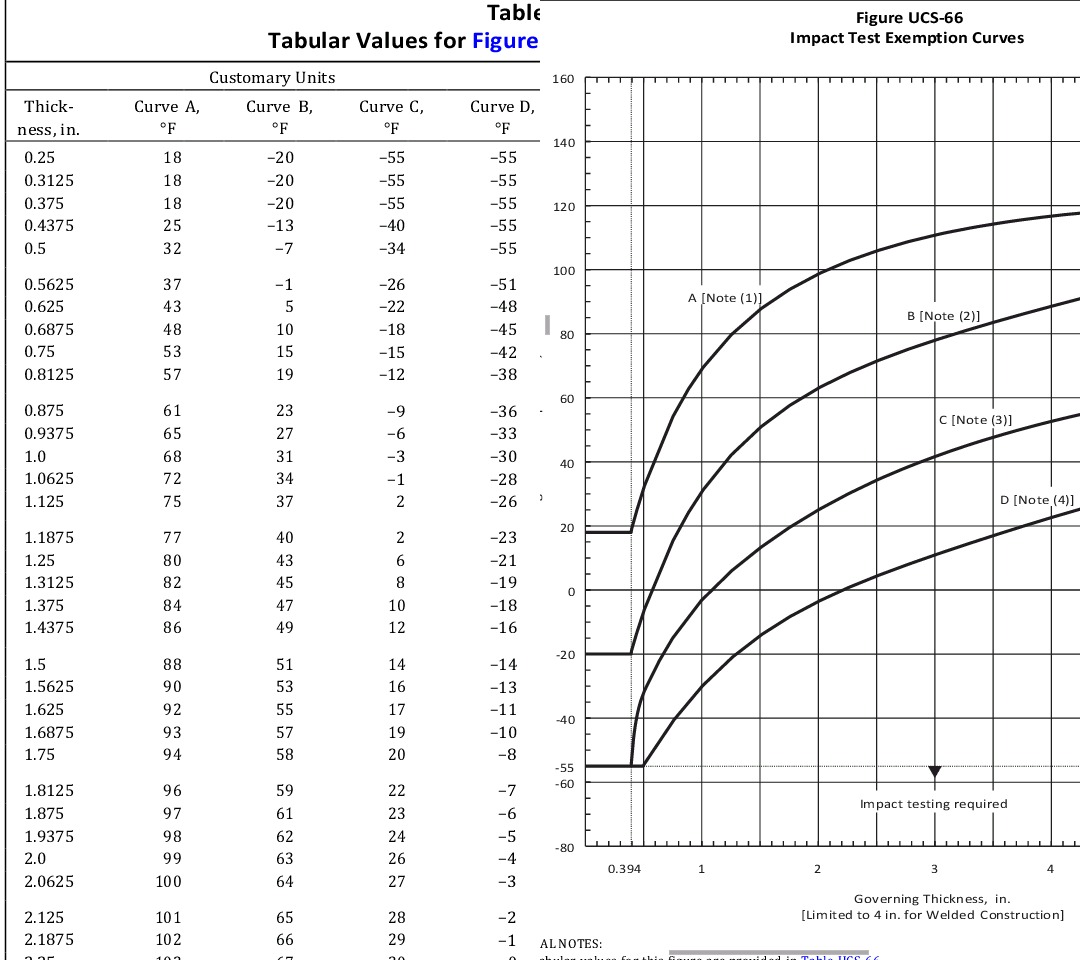
مقادیر داخل جدول UCS-66 معافیت برای قطعات جوش و غیر جوشی طبق توصیف زیر هستند :
- ضخامت حاکم در هر اتصال جوشی متجاوز از ۴ اینچ یا اتصال غیر جوشی بیش از ۶ اینچ و سردتر از ۵۰ درجه سانتیگراد دمای حداقل فلز ( MDMT ) تست ضربه متریال باید انجام شود.
نمونه ای از متریال هایی که در منحنی های مختلف قرار می گیرند :
متریال هایی که در Curve A قرار می گیرند
1) Curve A applies to:
(a) all carbon and all low alloy steel plates, structural shapes, and bars not listed in Curves B, C, and D below;
(b) SA-216 Grades WCB and WCC if normalized and tempered or water‐quenched and tempered;
SA-217 Grade WC6 if normalized and tempered or water‐quenched and tempered.
متریال هایی که در Curve B اعمال می شوند :
(2) Curve B applies to:
(a) see below: SA-216 Grade WCA if normalized and tempered or water‐quenched and tempered
SA-216 Grades WCB and WCC for thicknesses not exceeding 2 in. (50 mm) , if produced to fine grain practice and water‐quenched and tempered
SA-217 Grade WC9 if normalized and tempered
SA-285 Grades A and B
SA-299
SA-414 Grade A
SA-515 Grade 60
SA-516 Grades 65 and 70 if not normalized
SA-612 if not normalized
متریال هایی که در Curve C اعمال می شوند :
3) Curve C applies to:
(a) see below:
SA-182 Grades F21 and F22 if normalized and tempered
SA-302 Grades C and D
SA-336 F21 and F22 if normalized and tempered, or liquid quenched and tempered
SA-387 Grades 21 and 22 if normalized and tempered, or liquid quenched and tempered
SA-516 Grades 55 and 60 if not normalized
SA-533 Types B and C Class 1
SA-662 Grade A
متریال هایی که در داخل منحنی D قرار می گیرند :
(4) Curve D applies to:
SA-203
SA-299 if normalized
SA-508 Grade 1
SA-516 if normalized or quenched and tempered
SA-524 Classes 1 and 2
SA-537 Classes 1, 2, and 3
SA-612 if normalized
SA-662 if normalized
SA-738 Grade A
SA-738 Grade A with Cb and V deliberately added in accordance with the provisions of the material specification, not colder than −20°F (−29°C)
SA-738 Grade B not colder than −20°F (−29°C)
SA/AS 1548 Grades PT430N and PT460N
SA/EN 10028‐2 Grades P235GH, P265GH, P295GH, and P355GH if normalized
SA/EN 10028‐3 Grade P275NH
مرحله بعدی (UCS-66(b ، اگر ضریب ایمنی کمتر از یک باشد ، شکل UCS-66.1 ، مبنایی را برای داشتن MDMT سردتر که از شکل UCS-66a بدون آزمایش ضربه استخراج شده است ، فراهم می کند.
ASME Sec. VIII Div.1: UCS-66(b)
Coincident ratio = tr*E / (tn-c)
Where, tr = Design thickness
E = Joint efficiency
tn = Nominal thickness
c = Corrosion allowance
شکل UCS-66.1 کاهشی در MDMT بدون نیاز ضربه بر مبنای concident ratio فراهم می سازد
مرحله بعد (UCS-66(c ، برای فلنج های زیرین که MDMT سردتر از 29- درجه سانتیگراد ندارند تست ضربه نیاز نیست.
ASME B16.5 flanges of ferric steel
ASME B16.47 flanges of ferric steel
Split loose flanges of SA-216 Gr. WCB as per ASME B16.5 Class 150,300 Carbon and low alloy steel long weld neck flanges
مرحله بعد ( UCS-66(d ، برای متریال های UCS ( منظور کربن استیل ) با ضخامت ۲.۵ میلیمتر و کمتر تست ضربه نیاز نیست اما این چنین متریال های استثناء نباید در دماهای حداقل فلز کمتر از 48- درجه سانتیگراد بکارروند.
برای مخازن یا اجزاء ساخته شده از تیوب های DN 100 یا کمتر یا متریال های P نامبر یک ، معافیت های زیر از آزمایش ضربه نیز به عنوان تابعی از حداقل مقاومت تسلیم مشخص شده متریال (SMYS) برای دمای فلز 105- درجه سانتیگراد و گرمتر مجاز است :

مرحله آخر UCS-68 ، اگر تنش زدایی زمانیکه بطریق دیگری که الزامات این تقسیم نیست انجام پذیرد ، کاهش 17 درجه در دمای معافیت تست ضربه می تواند به دمای حداقل مجاز از شکل UCS-66 برای متریال های P نامبر یک داده شود.
UCS-68 DESIGN
(a) Welded joints shall comply with UW-2(b) when the minimum design metal temperature is colder than −55°F (−48°C), unless the coincident ratio defined in Figure UCS-66.1 is less than 0.35.
(b) Welded joints shall be postweld heat treated in accordance with the requirements of UW-40 when required by other rules of this Division. When the minimum design metal temperature is colder than −55°F (−48°C), and the coincident ratio defined in Figure UCS-66.1 is 0.35 or greater, postweld heat treatment is required, except that this requirement does not apply to the following welded joints, in vessels or vessel parts fabricated of P‐No. 1 materials that are impact tested at the MDMT or colder in accordance with UG-84.
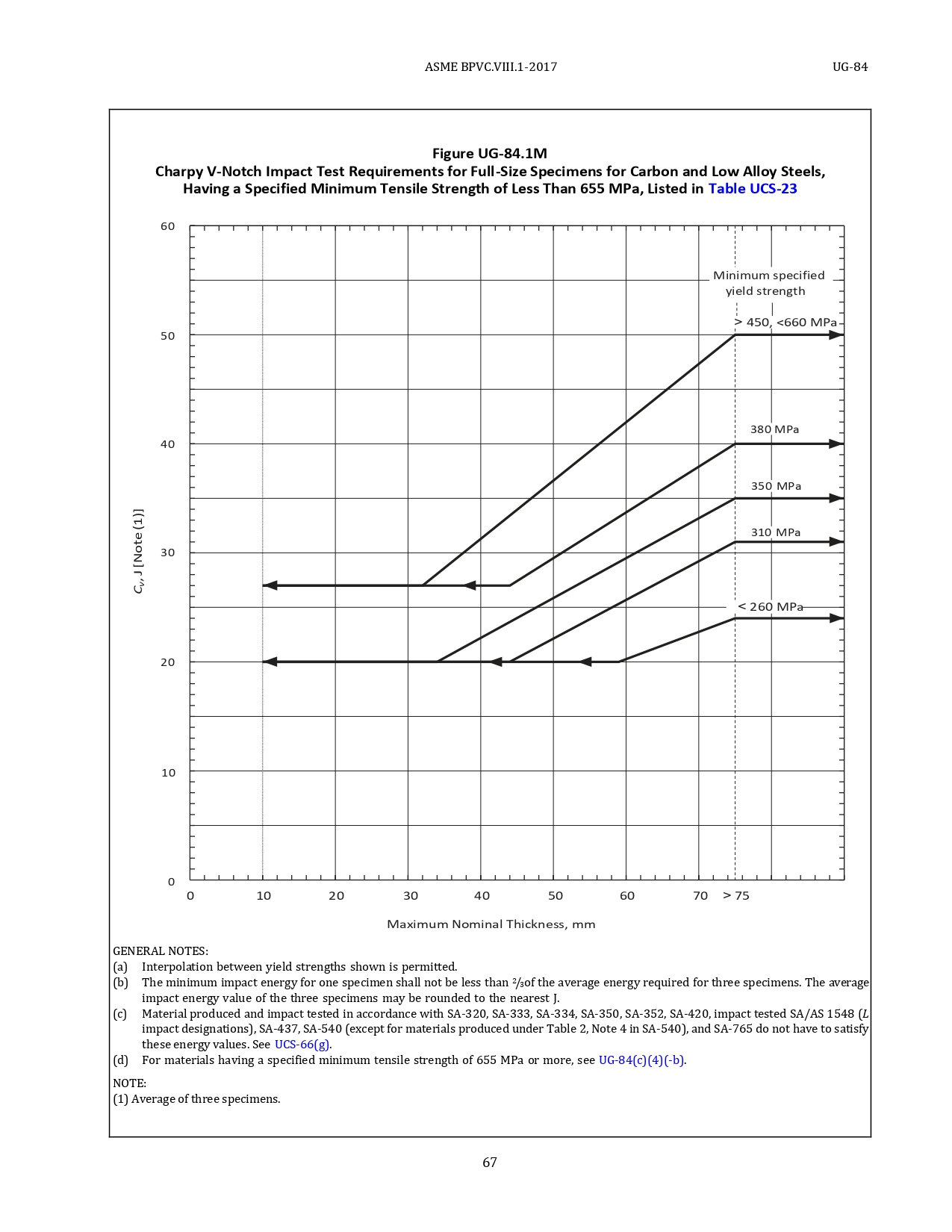
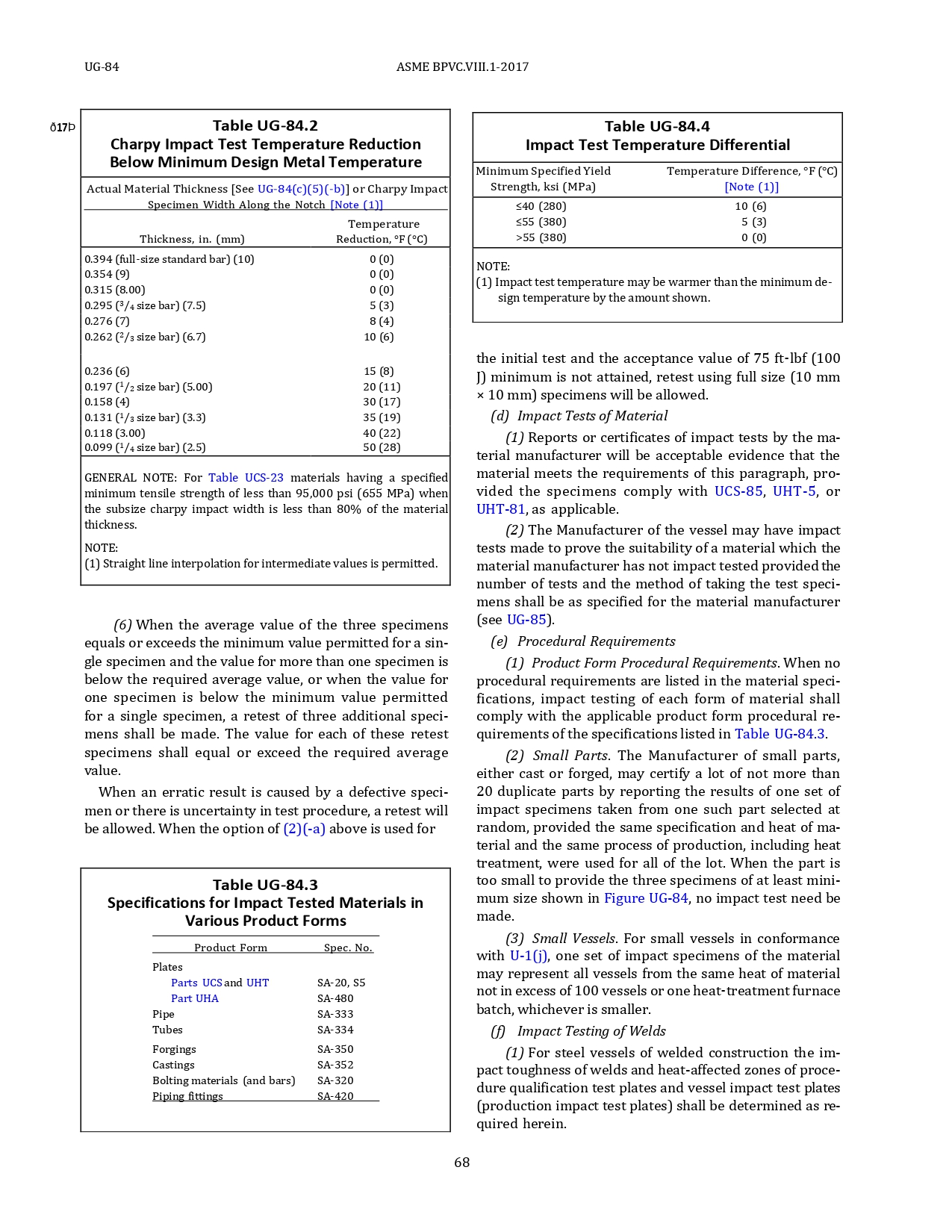
(a) Interpolation between yield strengths shown is permitted.
(b) The minimum impact energy for one specimen shall not be less than 2/3 of the average energy required for three specimens. The average impact energy value of the three specimens may be rounded to the nearest ft‐lb.
(d) For materials having a specified minimum tensile strength of 95 ksi or more, see UG-84(c)(4)(-b).
اندازه نمونه FullSize
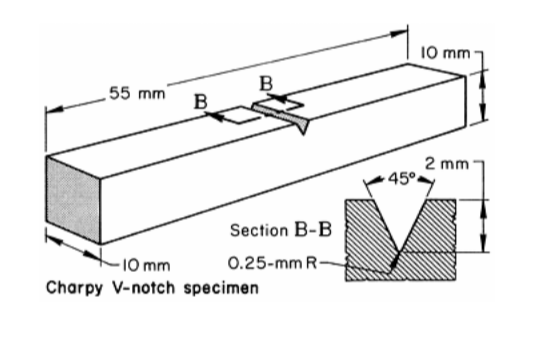
سایز استاندارد نمونه 10mm×10mm است .
تست تافنس برای نمونه 2.5mm نیاز نیست.
برای تمام اندازه های گرفته شده ، حداقل انرژی مورد نیاز با Tensile کمتر از 95000ksi طبق عدد شکل UG-84.1 در نسبت سایز نمونه گرفته شده به سایز استاندارد باید باشد.
The standard (10 mm × 10 mm) specimens, when obtainable, shall be used for nominal thicknesses of 7/16 in. (11 mm) or greater.
Toughness tests are not required where the maximum obtainable Charpy specimen has a width along the notch less than 0.099 in.(2.5mm)
the applicable minimum energy requirement for all specimen sizes for Table UCS-23 materials having a specified minimum tensile strength less than 95, 000 psi (655 MPa) shall be that shown in Figure UG-84.1, multiplied by the ratio of the actual specimen width along the notch to the width of a full‐size (10 mm × 10 mm) specimen
متریال SA-350 LF2 CLASS 1 در دمای 50- درجه فارنهایت تست ضربه انجام می شود . حداقل میانگین انرژی جذب شده برای 3 نمونه آزمون 15ft-lb است ، حداقل انرژی جذب شده 12ft-lb ( میانگین 15 و حداقل 12 ) . حداقل استحکام تسلیم متریال 36ksi است . طبق شکل 84.1 میانگین تست ضربه به 18ft-lb بالاتر میرود بخاطر اینکه متریال از 2 اینچ بیشتر است . حداقل مورد نیاز 2/3 میانگین یا 12ft-lb است ( میانگین 18 و حداقل 12 ).
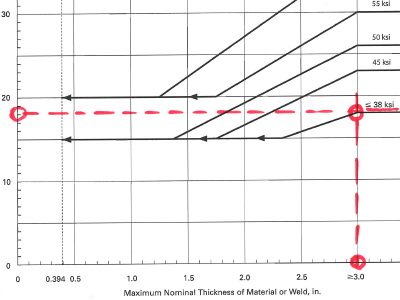
°F to °C : (°F − 32) / 1.8 = °C